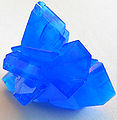Azure
Azure is a color that since ancient times has been applied to intense intermediate colors between light blue and indigo, so in modern color theory it can be considered that azure is a intermediate spectral color between cyan and blue, and therefore belongs to the natural color wheel.
On the other hand, in heraldry, azur is the heraldic denomination of an intense or dark blue color. Among the heraldic enamels, it belongs to the group of colors, together with gules (gules (red), sable (black), sinople (green) and purple.
Etymology and synonyms
The term «azur» comes from the French azur, which shares origin with «azul», which is considered derived from the Hispanic Arabic lazawárd, this from the Arabic lāzaward, 'lapis lazuli', this from Persian laǧvard or lažvard, and this from Sanskrit rājāvarta, 'curl of king'. Another interpretation holds that the Persian laǧvard or lažvard would derive from Lajward, a region of Turkestan where, according to Marco Polo, lapis lazuli, a semiprecious stone of colored blue.
In English, azure derives from Old Spanish azur. It refers to a deep blue, occasionally turning purple, similar to the color of a clear sky, that is, without clouds (sky blue).
Occasionally, this glaze has been called turkey.
Heraldry
History
At the beginning of heraldry, between the 12th and 13th centuries, azure was a rarely used enamel: the historian Michel Pastoureau found that it appeared in only 10 to 15% of European armories. However, towards the middle from the 14th century it had gained ground at the expense of gules and sable, becoming the predominant color in European coats of arms.
Representation
Azure is not exactly defined. Consequently, the tone and shade of blue to be used to represent it is at the discretion of the heraldic artist. It is recommended, however, that the blue be strong and true to its nature; should not be purple or greenish.
When colors are not available, azure can be represented by a very fine hatching of parallel horizontal lines, according to the method attributed to the Jesuit Silvestre Pietra Santa. This is the method of representation commonly seen in one-ink engravings.
Examples of use
Three notable ancient examples of the use of azure follow.
In the Tessé Museum, in Le Mans, there is an enamel plaque from the tomb of Godfrey Plantagenet that depicts him wielding his sword and shield (azur, strewn with golden lions). This effigy, which dates back to around 1160, is considered the oldest surviving color shield image.
Use in veros
Among the heraldic linings, the veros are typically azure and silver, although on rare occasions they can be other colors. It is believed that the azure of the veros comes from the fact that this heraldic motif, highly stylized today, was formerly a lining made with many gray squirrel skins, which were sewn together, alternating the pieces corresponding to the back (azur) with which they were taken from the bellies of animals (silver).
Use on the waves
The heraldic figure called «waves», as well as the partitions and wavy pieces, have been used with some frequency to represent bodies and currents of water (the sea, rivers, etc.); in these cases the suggestion of water is usually reinforced by the use of azure enamel.
In the case of waves, although they can be represented in any combination of color and metal, silver and azure are often used to refer to water.
Names, attributions and meanings in disuse
Towards the beginning of the Renaissance, a system of symbolic correspondences for heraldic colors was developed that is now in disuse. It is noteworthy that around 1828 this system was considered absurd by the English heraldist William Berry, although the Spanish Francisco Piferrer, in 1858, comments on it as if it were still valid.
Although Jean Courtois, Sicilian Herald of the Kingdom of Aragon, mentions in his treatise Le blason des couleurs (1414) that any of these associations of azure can be used to emblazon, in practice it is It is possible that only the planetary system and the system of precious stones were used. For Alberto and Arturo García Caraffa (1919), the emblazoned with gems corresponded to the titles and the one with planets to the sovereigns. Arthur Fox-Davies cites an example of emblazonment with precious stones dating from 1458.
Below are some of the ancient symbolic correspondences for azure, as well as some of the names attributed to it.
| Names "Greeks" | steel, Veneto, stag, detrady |
| Metal | copper, iron, steel |
| Planet | Jupiter, Venus |
| Beautiful stone | the sapphire |
| Zodiac Sign | Taurus and Libra |
| Element | the air |
| Station of the year | spring, autumn, summer |
| Month | April and September |
| Weekday | Friday, Thursday, Tuesday |
| Numbers | 4, 9 |
| Tree | the poplar, the oak |
| Flower | the blue, the old, the violet |
| Ave | The peacock |
| Cuadrupe | the chameleon |
| Age of man | Second childhood, fifteen years |
| Human complexion | blood, choleric |
| Theological and cardinal virtues | justice, strength |
| Virtues and worldly qualities | loyalty, science, beauty, praise, sweetness, clarity, purity, renown, nobility, perseverance, vigilance, recreation, zeal |
| Obligations of the carrier | defend the servants of the princes who have been left unpaid for their services |
The color azure today
Currently, azure is a color sometimes used in the field of decorative painting, cosmetics and others. The influence of the Italian language is important, where the color azzurro (see azzurri) is lighter than blu, but more intense than light blue. In English, azure is defined as the color of the clear sky. In Russian, Голубой (goluboi = sky blue and light blue) is defined as a different color from Синий (sinii = blue and dark blue).
Tones that are perceived as intermediate between blue and cyan can be called azure. Its complementary color is orange.
On the RGB color wheel, "blue" (hexadecimal #0080FF) is defined as the color at 210 degrees, that is, the hue halfway between blue and cyan. In the RGB color model, which is used to create all the colors on a television or computer screen, blue is created by adding 50% green light to 100% blue light.
In the X11 color system, which became a model for early web colors, blue is represented as pale cyan or white cyan.
Variations and similar colorings
| Name | Sample | Cod. Hex. | RGB | HSV | ||||
|---|---|---|---|---|---|---|---|---|
| Azure (web, Crayola) | #F0FFFF | 240 | 255 | 255 | 180° | 100% | 100% | |
| Clear Azur (painting) | #92CBF1 | 146 | 203 | 241 | 204° | 39% | 95% | |
| Intense celestial (X11) | #00BFFF | 0 | 191 | 255 | 195° | 100% | 100% | |
| Blue cian (CMYK) | #00B0F6 | 0 | 176 | 246 | 197° | 100% | 96% | |
| Blue azur | #8791BF | 135 | 145 | 191 | 229° | 29% | 75% | |
| Azur | #007FFF | 0 | 127 | 255 | 210° | 100% | 100% | |
| Genuine supplication | #0087D1 | 0 | 135 | 209 | 201° | 100% | 82% | |
| Azur (HTML) | #0066FF | 0 | 102. | 255 | 216° | 100% | 100% | |
| Azur (oleum) | #0071D1 | 0 | 113 | 209 | 208° | 100% | 82% | |
| Blue azur (RAL) | #025669 | 2 | 86 | 105 | 191° | 98% | 41% | |
Gallery
Contenido relacionado
Guitar
Antoni Gaudí
Icelandic art














